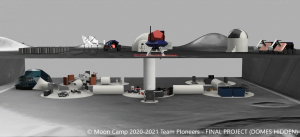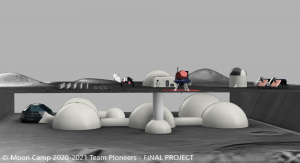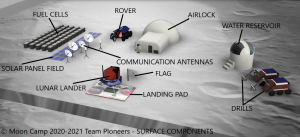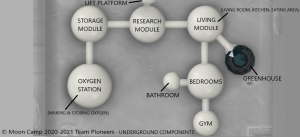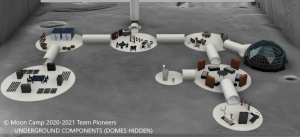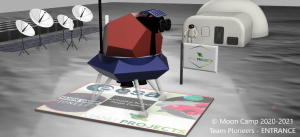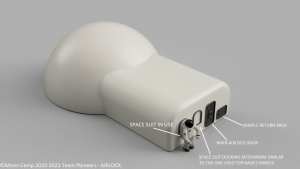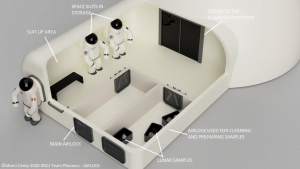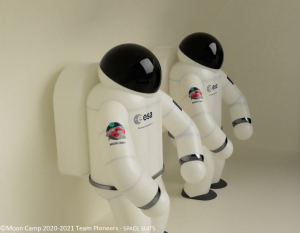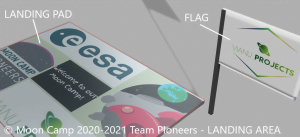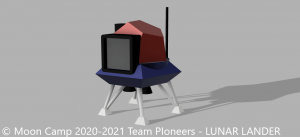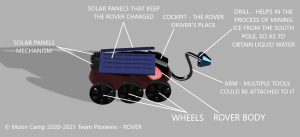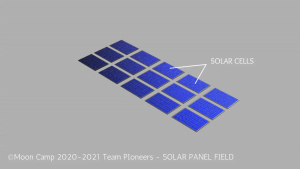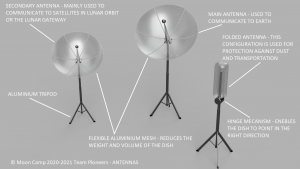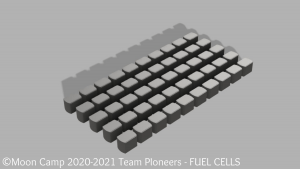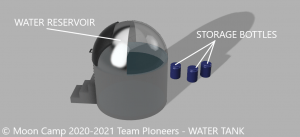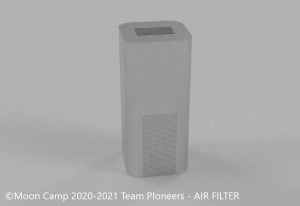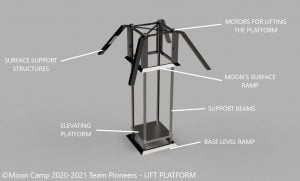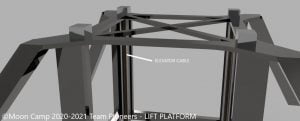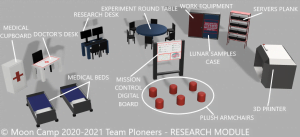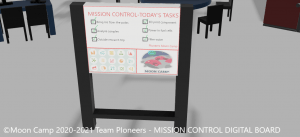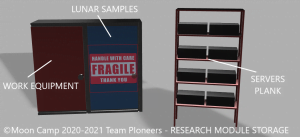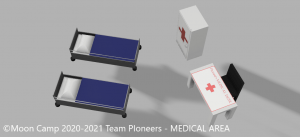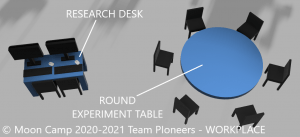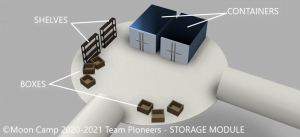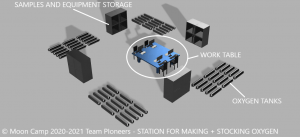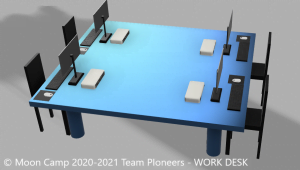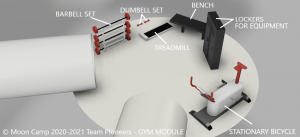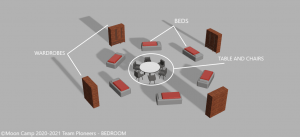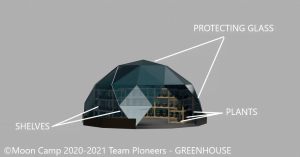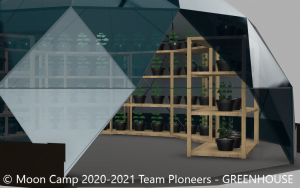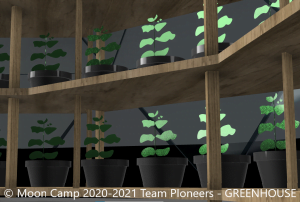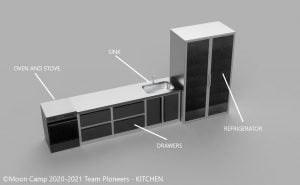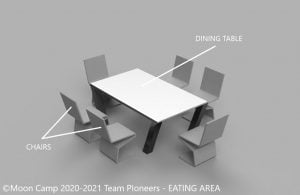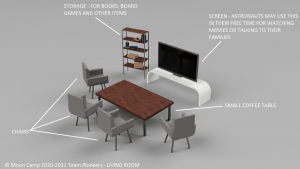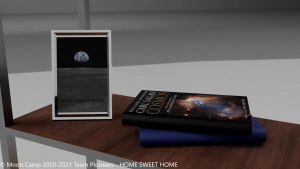Moon Camp Pioneers Gallery 2020-2021
In Moon Camp Pioneers each team’s mission is to 3D design a complete Moon Camp using Fusion 360. They also have to explain how they will use local resources, protect astronauts from the dangerous of space and describe the living and working facilities.
Team: PIoneers
Tudor Vianu National High School of Computer Science Bucharest Romania 15 Third Place – ESA Member States
External viewer for 3d project
|
Project description
PIoneers (wordplay including the constant PI) is the name that best describes our team, considering that our moon camp will be a hub for ground-breaking scientific research for decades to come. We hope our settlement can become a stepping stone in expanding human presence in the solar system by developing and testing the crucial technologies needed for planetary colonization. Firstly, we plan to build our camp in a lava tube near the south pole, the most convenient spot on the moon in terms of similarity to Earth temperature, and where water ice, an essential resource that enables astronaut presence, can also be found. Our base will consist of modules, starting with habitats, science labs, and stations for making oxygen. In this way, it will be easy to introduce new areas. Some of the first modules will be pre-fabricated on Earth and assembled on the moon, and, as we discover the need for new spaces, we’d start building them with materials available on the moon. Besides, not only do we minimize the possible dangers by placing our camp in a lava tube, but we also incorporate redundant systems. The vital resources humans require are water (mined from south pole ice), food (produced in a lunar greenhouse), power (from solar panels), and air (by electrolysis from the plants and also by using regolith). Therefore, we create an environment where astronauts can undoubtedly adapt and focus on their work as lunar researchers, life conditions being as similar as possible to those on Earth. |
|||
|
Where do you want to build your Moon Camp?
We aim to build our base near the lunar south pole, where lava tubes would be the enclosure of human habitat. Our top priority was to find a spot with decent living conditions for the astronauts who will accommodate the moon camp. Therefore, our choice was limited to the poles, where temperatures range from -50°C to 0°C, people get constant sunlight, and, inside the lava tubes, temperatures are bearable. The decisive argument in favour of the south pole was the presence of water ice out of which we could obtain liquid water, indispensable for the people living on our moon camp. What is more, the craters in the south pole area block the sunlight from going inside (a strong point so as the astronauts would be able to sleep well) and contain a fossil record of hydrogen, which we could use for breathable air, but most importantly, for fuel. How do you plan to build your Moon Camp? Describe the techniques and materials you would use.
Taking into account that we have in mind building the Moon Camp in a lava tube and the fact that they can be very large in diameter, the main idea would be to make it on the bottom of the lava tube and use an elevator (image 19) to get to the surface of the moon. Ideally, the camp should be modular so that integrating new parts would be easier. Such modules can be habitats, science labs, stations for making oxygen, and more. The living modules will be connected with airtight tubes, to limit the number of airlocks needed. Those modules also need to be airtight and have a strong outer shell to protect them from radiation and potential debris. The shape will be a dome to disperse the stress. At first, the moon base will be pre-made on Earth from materials like titanium for its hardness (especially the shell), but later we can expand with buildings made from lunar concrete, which is a mixture of sulphur and aggregate resources accessible from the moon. The environment on the Moon is very dangerous for the astronauts. Explain how your Moon Camp will protect them.
Firstly, we should protect the astronauts from moon dust, the 354-hour day-night cycle, radiation, earthquakes, and micrometeorite blasts. By settling inside a lava tube at the south pole where astronauts can enjoy sunlight, we overcome many dangers. The soil is a great way to protect astronauts from radiation and micrometeorites. Because the moon dust can cause breathing issues and deterioration if it enters our shelter, we will have filters and a strong airflow so that the sharp and abundant silica won’t get it. Besides, there will be an airlock (image 8) where astronauts could clean off the dust before entering the living area. We plan to reinforce the lava tube walls to prevent their potential collapse during an earthquake. With the near-perpetual sunlight from the south pole, we can generate electricity in a relatively cheap way, so our base will also have artificial light and a much-needed heating system. Explain how your Moon Camp will provide the astronauts with:
|
|||
|
Water
|
Food
|
Electricity
|
Air
|
|
Water is a vital resource humans need to survive, so we paid much attention to this topic. Our main idea is that astronauts can remove water ice from the poles to co-exist on the moon, but with the required special equipment due to high temperatures, of course. Then, we will use a drill with solar panels on top of it (image 13). In this way, the tool will heat and penetrate inside the thick layer of the moon. Thus, we’ll be able to use other solar panels to melt it after we extract the ice. With the aid of professional equipment, we can then filter the water and generate healthy drinking water. We intend to perform this process twice a week and collect the remaining water in a reservoir (image 17). We can also use the water recycling system on the International Space Station for filtration. |
In short, food equals energy, and our astronauts need plenty of it. First of all, to be as efficient as possible, the food taken into space must be lightweight, compact, tasty, nutritious, and durable for long periods without refrigeration. However, no matter how much food astronauts bring on the moon, it still won’t be enough. Therefore, we must also produce food on the moon. Our idea involves an essential lunar greenhouse to cover the lack of atmosphere or natural water and protect the plants from high temperatures. Plants grown inside our greenhouse in regolith include potatoes & radishes (vitamin C), tomatoes (vitamin A), celery (potassium), Arabidopsis thaliana (a flowering plant), silkworm eggs (protein), and lettuce (calcium), which will provide our space explorers with the much-needed nutrients. The astronauts would provide carbon dioxide by breathing and extract water for the plants from their urine by using the Water Recycling System. |
For gathering energy, we noted there are some spots on the moon, such as the rim of the Shackleton crater on the South Pole, which have permanent sunlight, and to prevent the problem of the moon nights that last for too long, we placed our moon camp in that South Pole area. Therefore, we could put solar panels there (image 14), but we also need some rovers (image 12) to bring energy to the base. Then, we can store solar power in fuel cells (image 16), which can last 17 days straight when fully charged. In this way, we also avoid the problem of lunar eclipses when Earth entirely blocks sunlight. |
The most important thing that man cannot live without is air, so we had to think seriously about this part of the project. First of all, before we leave Earth, we’re going to make some “supplies” with enough oxygen for the first few days on the moon, and we’re going to start getting it once we reach our destination (oxygen station: image 27). Plants are a means of generating air and can be used for both air and food. However, as they take up quite a lot of space by electrolysis, we can use the water left in the reservoir as well. Moreover, we can process the oxygen-rich regolith. One experimentally proven method is molten salt electrolysis which involves mixing the lunar soil at high temperatures with calcium chloride, and then, by running a current through the mixture, the oxygen gathers around the anode where it is harvested. |
|
Explain what would be the main purpose of your Moon Camp (for example: commercial, scientific, and/or tourist purposes).
The base purpose of our moon camp will be scientific, but our team has designed the settlement so that it could easily be repurposed once human presence would inevitably start growing on the lunar surface. After considering the astronomical costs and many risks associated with the initial missions to the moon, we have decided that our first settlers should be scientists and engineers. We believe they will be best suited to properly run the daily experiments while also maintaining and upgrading the complex systems of the settlement. As there will be more and more human moon missions, costs will go down, and technology will progress, becoming more efficient and reliable. Once this happens, the moon camp can simply be expanded to accommodate more people, some of whom could even be tourists, thus expanding humanity’s presence on the moon. |
|||
|
Describe a day on the Moon for your Moon Camp astronaut crew.
We find it crucial that we always have somebody awake in case of emergency, so we have decided that the astronauts will have different sleep cycles. As a result, the crew will be divided equally into three shifts (that overlap for about two hours for social purposes, the whole team getting together at that time), so experiments run 24/7. No matter what shift the astronaut is in, after waking up, he will do his hygiene and then have breakfast in the eating area of our base (image 36). Following breakfast, the crew will go to the gym module (image 29), where each member will get at least a minimum amount of physical exercise to keep fit, healthy and combat the negative effects of the lower gravity on the human body. Afterwards, each crew member will receive his respective tasks from ground control (image 22), and start working on the assigned work inside the research module (image 21) or, on special occasions, they may go outside to study the moon environment. After half of the working period, the crew will benefit from a one-hour lunch break and have a meal that consists of greenhouse foods (image 33). Then, the astronauts would get back to work until the end of the 8-hour researching program. Next, the crew will have dinner, followed by some free time when everybody could choose what activities they want to do so as to unwind (talk to their families or read a book, for instance). To gain more unity inside the team, once a week, the astronauts could take part in special activities, such as having a movie night and playing board games in the living room (image 37). After a busy day, the astronauts will do their hygiene (bathroom: image 30) and return to their quarters (image 31) to sleep for about 8 hours, as rest is of the utmost importance for coping with the stress and tough conditions of the lunar surface. |
|||


